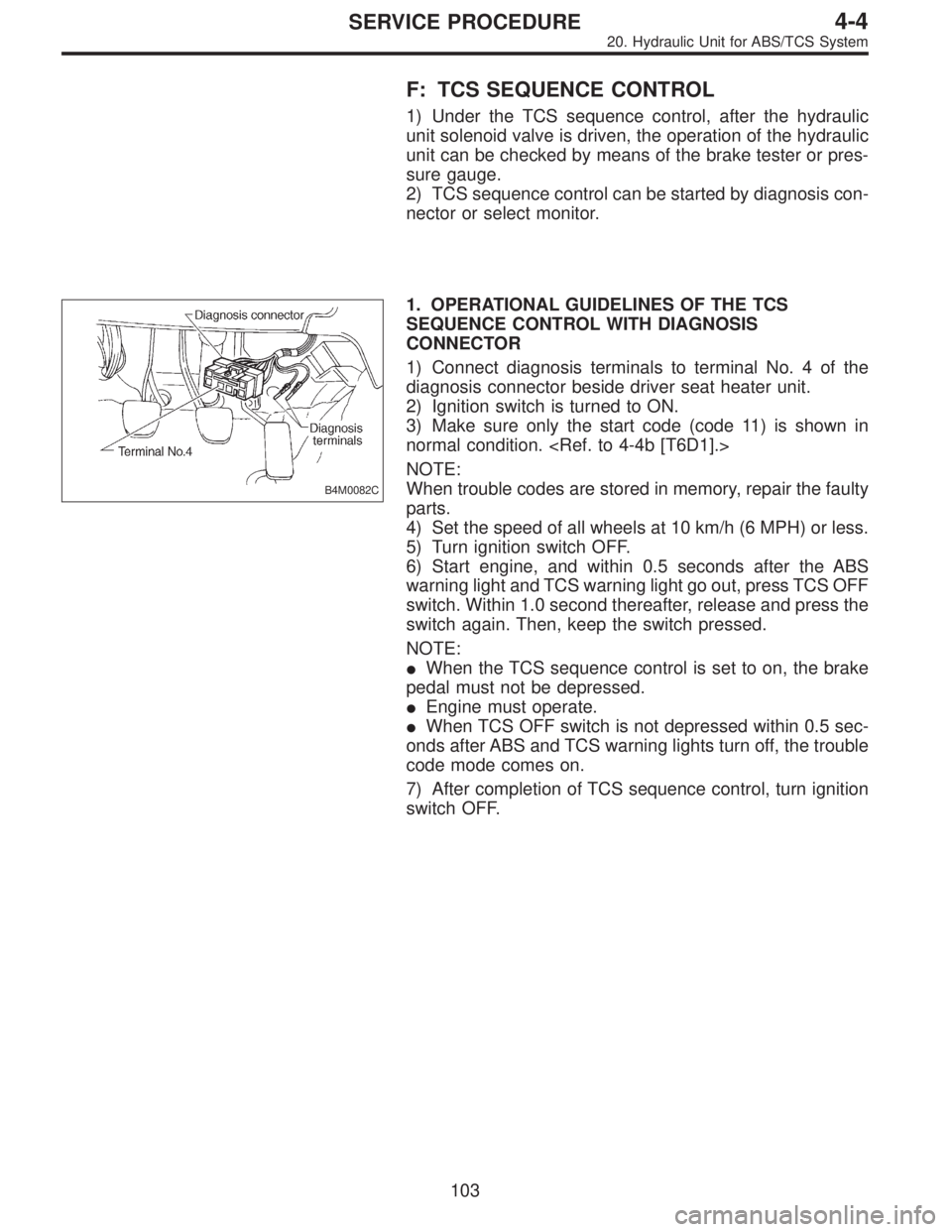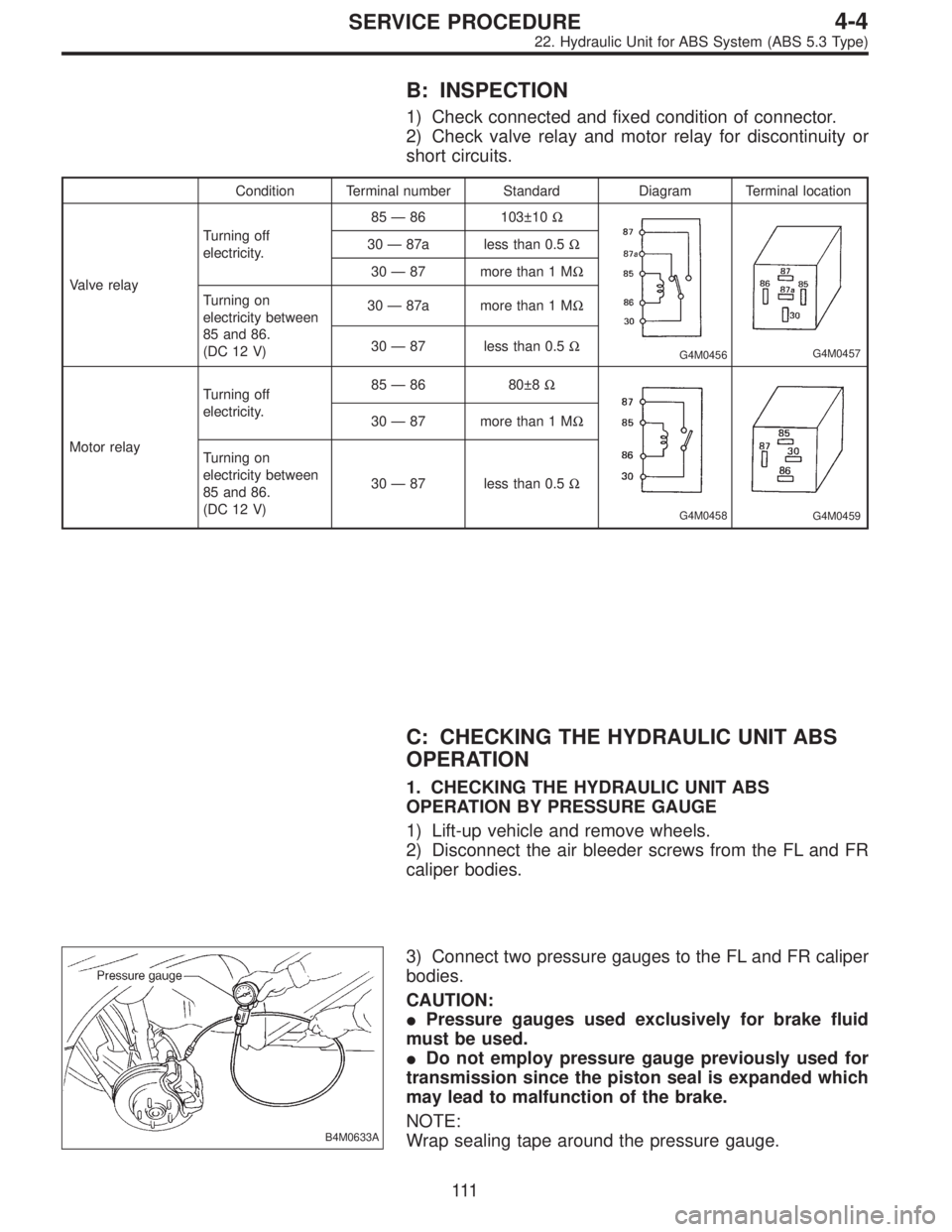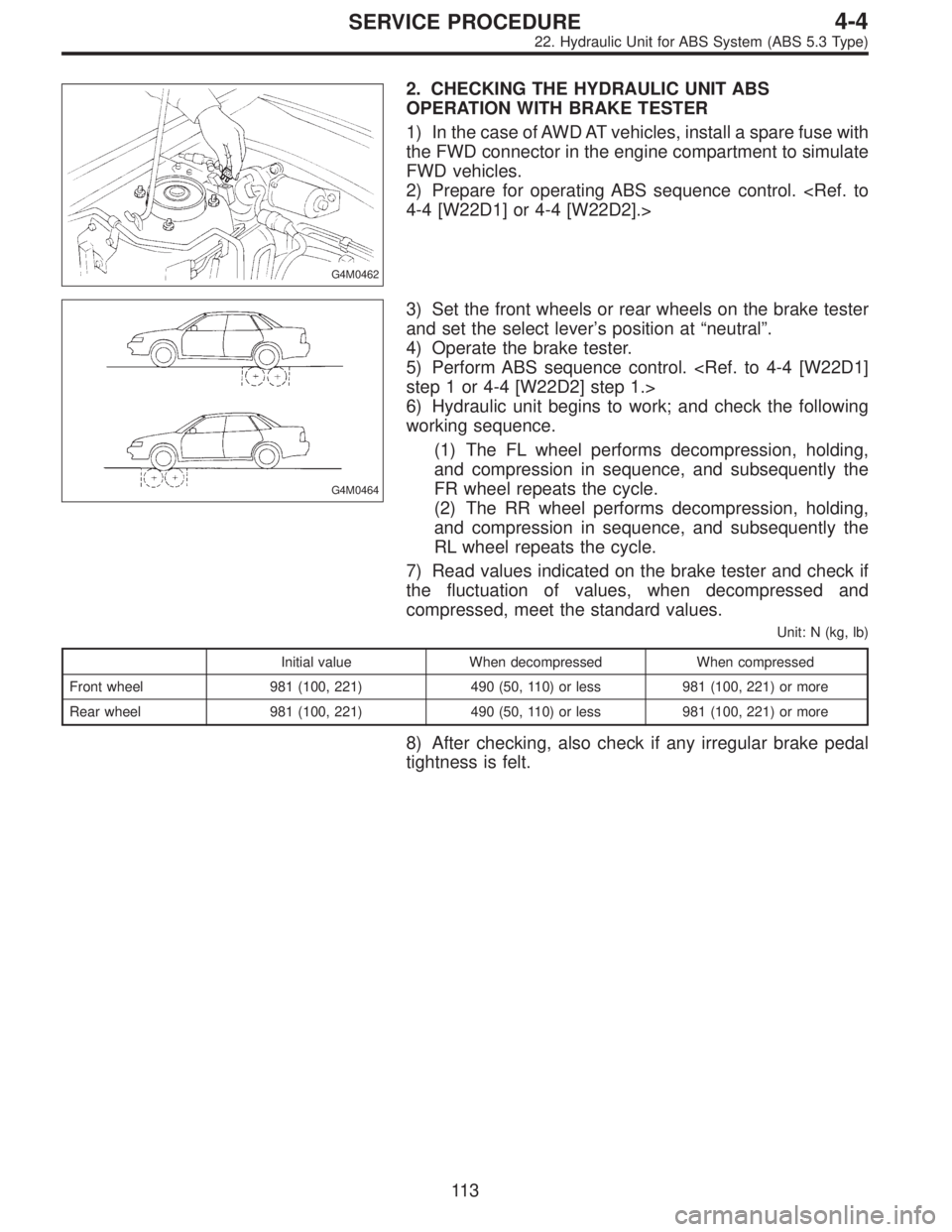Page 1308 of 2890
3. CONDITIONS FOR COMPLETION OF ABS
SEQUENCE CONTROL
When the following conditions develop, the ABS sequence
control stops and ABS and TCS warning lights come on
while the ABS and TCS function will then stop. The brake
system functions as a conventional brake system.
1) When the speed of at least one wheel reaches 10 km/h
(6 MPH).
2) When terminal No.4 is separated from ground. (When
select monitor is not used.)
3) When the brake pedal is released during sequence con-
trol and the braking lamp switch is set to off.
4) After completion of the sequence control.
5) When malfunction is detected.
NOTE:
When malfunction has been detected and the ABS
sequence control operation has stopped, the trouble codes
are stored in memory.
99
4-4SERVICE PROCEDURE
20. Hydraulic Unit for ABS/TCS System
Page 1310 of 2890

E: CHECKING THE HYDRAULIC UNIT TCS
OPERATION
1. CHECKING THE HYDRAULIC UNIT TCS
OPERATION BY PRESSURE GAUGE
1) Lift-up vehicle and remove wheels.
2) Disconnect the air bleeder screws from the FL and FR
caliper bodies.
B4M0633A
3) Connect two pressure gauges to the FL and FR caliper
bodies.
CAUTION:
�Pressure gauges used exclusively for brake fluid
must be used.
�Do not employ pressure gauge previously used for
transmission since the piston seal is expanded which
may lead to malfunction of the brake.
NOTE:
Wrap sealing tape around the pressure gauge.
4) Bleed air from the pressure gauges.
5) Perform sequence control.
6) When the hydraulic unit begins to work, and first the FL
side performs compression, holding, and decompression,
and then the FR side performs compression, holding, and
decompression.
7) Read values indicated on the pressure gauge and
check if the fluctuation of the values between compression
and decompression meets the standard values. Also check
if any irregular brake pedal tightness is felt.
Initial value When compressed When decompressed
Front left wheel490 kPa (5 kg/cm
2, 71 psi)
or less1,471 kPa (15 kg/cm2, 213 psi)
or more490 kPa (5 kg/cm2, 71 psi)
or less
Front right wheel490 kPa (5 kg/cm
2, 71 psi)
or less1,471 kPa (15 kg/cm2, 213 psi)
or more490 kPa (5 kg/cm2, 71 psi)
or less
8) After checking, remove the pressure gauges from the
caliper bodies.
9) Connect the air bleeder screws to the FL and FR cali-
per bodies.
10) Bleed air from brake line.
101
4-4SERVICE PROCEDURE
20. Hydraulic Unit for ABS/TCS System
Page 1311 of 2890
2. CHECKING THE HYDRAULIC UNIT TCS
OPERATION WITH BRAKE TESTER
1) Prepare for operating TCS sequence control.
4-4 [W20F1] step 1 or 4-4 [W20F2] step 1.>
B4M0638
2) Set the front wheels on the brake tester and set the
select lever’s position at“neutral”.
3) Operate the brake tester.
4) Perform sequence control.
[W20F2].>
5) Hydraulic unit begins to work; and check the following
working sequence.
The front left wheel performs compression, holding,
and decompression in sequence, and subsequently the
front right wheel repeats the cycle.
6) Read values indicated on the brake tester and check if
the fluctuation of values, when decompressed and
compressed, meet the standard values.
When compressed When decompressed
Front left wheel 981—1,471 N (100—150 kg, 221—331 lb) 245 N (25 kg, 55 lb) or less
Front right wheel 981—1,471 N (100—150 kg, 221—331 lb) 245 N (25 kg, 55 lb) or less
102
4-4SERVICE PROCEDURE
20. Hydraulic Unit for ABS/TCS System
Page 1312 of 2890

F: TCS SEQUENCE CONTROL
1) Under the TCS sequence control, after the hydraulic
unit solenoid valve is driven, the operation of the hydraulic
unit can be checked by means of the brake tester or pres-
sure gauge.
2) TCS sequence control can be started by diagnosis con-
nector or select monitor.
B4M0082C
1. OPERATIONAL GUIDELINES OF THE TCS
SEQUENCE CONTROL WITH DIAGNOSIS
CONNECTOR
1) Connect diagnosis terminals to terminal No. 4 of the
diagnosis connector beside driver seat heater unit.
2) Ignition switch is turned to ON.
3) Make sure only the start code (code 11) is shown in
normal condition.
NOTE:
When trouble codes are stored in memory, repair the faulty
parts.
4) Set the speed of all wheels at 10 km/h (6 MPH) or less.
5) Turn ignition switch OFF.
6) Start engine, and within 0.5 seconds after the ABS
warning light and TCS warning light go out, press TCS OFF
switch. Within 1.0 second thereafter, release and press the
switch again. Then, keep the switch pressed.
NOTE:
�When the TCS sequence control is set to on, the brake
pedal must not be depressed.
�Engine must operate.
�When TCS OFF switch is not depressed within 0.5 sec-
onds after ABS and TCS warning lights turn off, the trouble
code mode comes on.
7) After completion of TCS sequence control, turn ignition
switch OFF.
103
4-4SERVICE PROCEDURE
20. Hydraulic Unit for ABS/TCS System
Page 1314 of 2890
3. CONDITIONS FOR COMPLETION OF TCS
SEQUENCE CONTROL
When the following conditions develop, the TCS sequence
control stops and ABS and TCS warning lights come on
while the ABS and TCS function will then stop. The brake
system functions as a conventional brake system.
1) When the speed of at least one wheel reaches 10 km/h
(6 MPH).
2) When terminal No. 4 is separated from ground. (When
select monitor is not used.)
3) When the brake pedal is depressed during sequence
control and the braking lamp switch is set to ON.
4) When TCS OFF switch is released. (When select moni-
tor is not used.)
5) After completion of the TCS sequence control.
6) When output signal to break TCS control is emitted from
ECM.
7) When malfunction is detected.
NOTE:
When malfunction has been detected and the TCS
sequence control operation has stopped, the trouble codes
are stored in memory.
105
4-4SERVICE PROCEDURE
20. Hydraulic Unit for ABS/TCS System
Page 1321 of 2890

B: INSPECTION
1) Check connected and fixed condition of connector.
2) Check valve relay and motor relay for discontinuity or
short circuits.
Condition Terminal number Standard Diagram Terminal location
Valve relayTurning off
electricity.85—86 103±10Ω
G4M0456G4M0457
30—87a less than 0.5Ω
30—87 more than 1 MΩ
Turning on
electricity between
85 and 86.
(DC 12 V)30—87a more than 1 MΩ
30—87 less than 0.5Ω
Motor relayTurning off
electricity.85—86 80±8Ω
G4M0458G4M0459
30—87 more than 1 MΩ
Turning on
electricity between
85 and 86.
(DC 12 V)30—87 less than 0.5Ω
C: CHECKING THE HYDRAULIC UNIT ABS
OPERATION
1. CHECKING THE HYDRAULIC UNIT ABS
OPERATION BY PRESSURE GAUGE
1) Lift-up vehicle and remove wheels.
2) Disconnect the air bleeder screws from the FL and FR
caliper bodies.
B4M0633A
3) Connect two pressure gauges to the FL and FR caliper
bodies.
CAUTION:
�Pressure gauges used exclusively for brake fluid
must be used.
�Do not employ pressure gauge previously used for
transmission since the piston seal is expanded which
may lead to malfunction of the brake.
NOTE:
Wrap sealing tape around the pressure gauge.
111
4-4SERVICE PROCEDURE
22. Hydraulic Unit for ABS System (ABS 5.3 Type)
Page 1322 of 2890
![SUBARU LEGACY 1996 Service Repair Manual 4) Bleed air from the pressure gauges.
5) Perform ABS sequence control.
<Ref. to 4-4 [W22D0].>
6) When the hydraulic unit begins to work, and first the FL
side performs decompression, holding, and com SUBARU LEGACY 1996 Service Repair Manual 4) Bleed air from the pressure gauges.
5) Perform ABS sequence control.
<Ref. to 4-4 [W22D0].>
6) When the hydraulic unit begins to work, and first the FL
side performs decompression, holding, and com](/manual-img/17/57433/w960_57433-1321.png)
4) Bleed air from the pressure gauges.
5) Perform ABS sequence control.
6) When the hydraulic unit begins to work, and first the FL
side performs decompression, holding, and compression,
and then the FR side performs decompression, holding,
and compression.
7) Read values indicated on the pressure gauge and
check if the fluctuation of the values between decompres-
sion and compression meets the standard values. Also
check if any irregular brake pedal tightness is felt.
Initial value When decompressed When compressed
Front wheel 3,432 kPa (35 kg/cm
2, 498 psi)490 kPa (5 kg/cm2, 71 psi)
or less3,432 kPa (35 kg/cm2, 498 psi)
or more
Rear wheel 3,432 kPa (35 kg/cm
2, 498 psi)490 kPa (5 kg/cm2, 71 psi)
or less3,432 kPa (35 kg/cm2, 498 psi)
or more
8) Remove pressure gauges from FL and FR caliper bod-
ies.
9) Remove air bleeder screws from the RL and RR caliper
bodies.
10) Connect the air bleeder screws to the FL and FR cali-
per bodies.
11) Connect two pressure gauges to the RL and RR cali-
per bodies.
12) Bleed air from the pressure gauges and the FL and FR
caliper bodies.
13) Perform ABS sequence control.
14) When the hydraulic unit begins to work, at first the RR
side performs decompression, holding, and compression,
and then the RL side performs decompression, holding,
and compression.
15) Read values indicated on the pressure gauges and
check if they meet the standard value.
16) After checking, remove the pressure gauges from cali-
per bodies.
17) Connect the air bleeder screws to RL and RR caliper
bodies.
18) Bleed air from brake line.
11 2
4-4SERVICE PROCEDURE
22. Hydraulic Unit for ABS System (ABS 5.3 Type)
Page 1323 of 2890

G4M0462
2. CHECKING THE HYDRAULIC UNIT ABS
OPERATION WITH BRAKE TESTER
1) In the case of AWD AT vehicles, install a spare fuse with
the FWD connector in the engine compartment to simulate
FWD vehicles.
2) Prepare for operating ABS sequence control.
4-4 [W22D1] or 4-4 [W22D2].>
G4M0464
3) Set the front wheels or rear wheels on the brake tester
and set the select lever’s position at“neutral”.
4) Operate the brake tester.
5) Perform ABS sequence control.
step 1 or 4-4 [W22D2] step 1.>
6) Hydraulic unit begins to work; and check the following
working sequence.
(1) The FL wheel performs decompression, holding,
and compression in sequence, and subsequently the
FR wheel repeats the cycle.
(2) The RR wheel performs decompression, holding,
and compression in sequence, and subsequently the
RL wheel repeats the cycle.
7) Read values indicated on the brake tester and check if
the fluctuation of values, when decompressed and
compressed, meet the standard values.
Unit: N (kg, lb)
Initial value When decompressed When compressed
Front wheel 981 (100, 221) 490 (50, 110) or less 981 (100, 221) or more
Rear wheel 981 (100, 221) 490 (50, 110) or less 981 (100, 221) or more
8) After checking, also check if any irregular brake pedal
tightness is felt.
11 3
4-4SERVICE PROCEDURE
22. Hydraulic Unit for ABS System (ABS 5.3 Type)